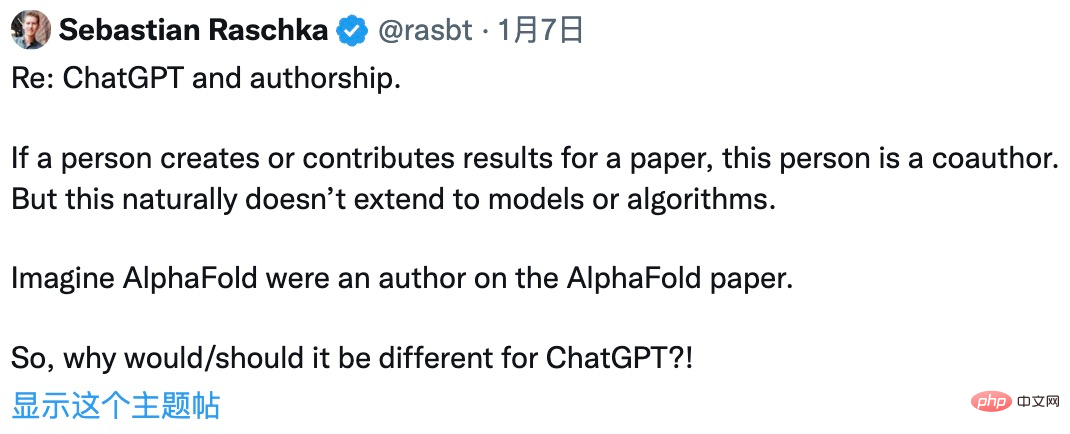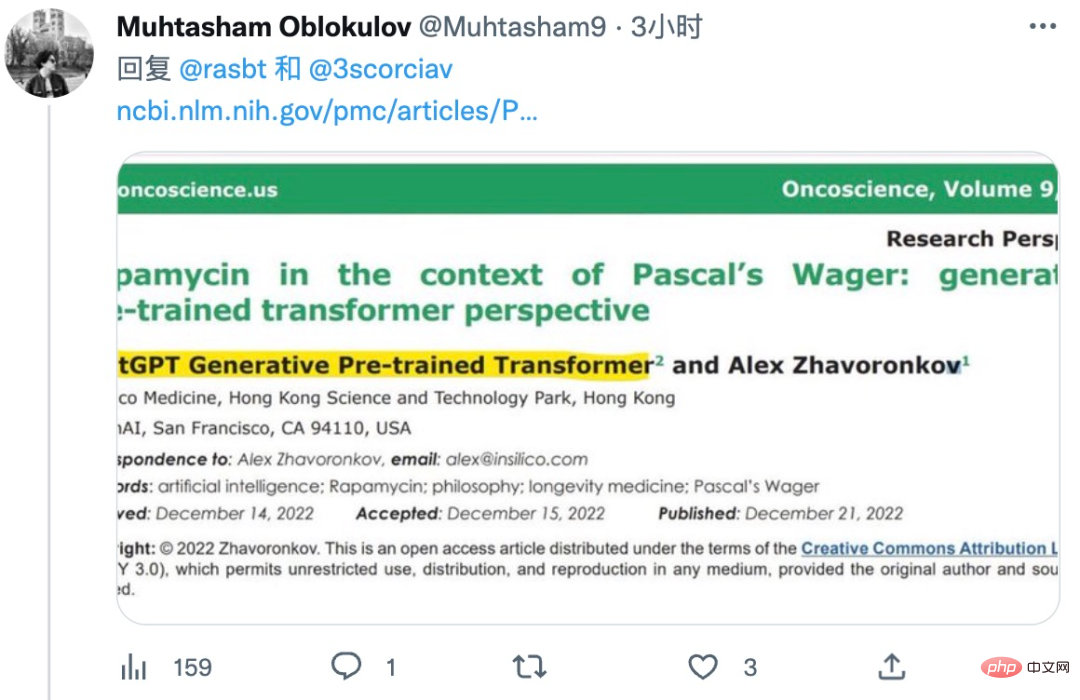 Technology peripherals
Technology peripherals
 AI
AI
 An author of a paper is popular. When can large language models such as ChatGPT become a co-author of the paper?
An author of a paper is popular. When can large language models such as ChatGPT become a co-author of the paper?
An author of a paper is popular. When can large language models such as ChatGPT become a co-author of the paper?
ChatGPT has received attention since its release and is considered one of the most powerful language models currently available. Its text generation capabilities are no less than those of humans, and some machine learning experts have even banned researchers from using ChatGPT to write papers.
But recently, a paper was clearly signed ChatGPT in the author column. What's going on?
This paper is "Performance of ChatGPT on USMLE: Potential for AI-Assisted Medical Education Using Large Language Models" published on the medical research paper platform medRxiv. ChatGPT is the first part of the paper. Three authors.

As can be seen from the title of the paper, the main content of this paper is to study the performance of ChatGPT in the United States Medical Licensing Examination (USMLE). Experimental results show that, without any special training or reinforcement, ChatGPT’s scores in all exams reached or were close to the passing threshold. Moreover, the answers generated by ChatGPT show a high degree of consistency and insight. The study suggests that large language models may be useful in medical education and may aid clinical decision-making.
Judging from the content of the research, ChatGPT seems to be more like a research object, as a Twitter user said: "If human researchers contribute to the experimental results, then of course they He is a co-author of the paper, but there is no such precedent for models and algorithms."

However, another netizen immediately refuted him in the comment area : A previous paper titled "Rapamycin in the context of Pascal's Wager: generative pre-trained transformer perspective" was not only signed, but ChatGPT was even the first author.

This paper is included in Oncoscience from the National Institutes of Health (NIH). However, from the contributions of the paper's authors, we found that most of the content of this paper was indeed generated by ChatGPT - Alex Zhavoronkov, the second author of the paper, asked ChatGPT questions related to the research topic, and ChatGPT automatically generated a large number of opinions and explanations, and then Content generated by ChatGPT is moderated by Alex Zhavoronkov. In addition, ChatGPT also assists in formatting the paper.

##Screenshot of the paper "Rapamycin in the context of Pascal's Wager: generative pre-trained transformer perspective".
#When deciding on the signature of the paper, Alex Zhavoronkov contacted OpenAI co-founder and CEO Sam Altman for confirmation, and finally published this article with ChatGPT as the first author. paper. This suggests that powerful AI systems such as large language models will make meaningful contributions to academic work in the future, and even have the ability to become co-authors of papers.
However, there are also some drawbacks to allowing large language models to write academic papers. For example, the top machine learning conference ICML said: "ChatGPT is trained on public data, which is often collected without consent. Collected under certain conditions, this will bring about a series of responsibility attribution issues."
In a recent study by Catherine Gao and others at Northwestern University, the researchers selected some data published in Manually research papers in the Journal of the American Medical Association (JAMA), New England Journal of Medicine (NEJM), British Medical Journal (BMJ), The Lancet and Nature Medicine, use ChatGPT to generate abstracts for the papers, and then test the review Can a human detect that these summaries are generated by AI?
Experimental results show that reviewers correctly identified only 68% of the generated abstracts and 86% of the original abstracts. They incorrectly identified 32% of generated summaries as original summaries and 14% of original summaries as AI-generated. The reviewer said: "It is surprisingly difficult to distinguish between the two, and the generated summary is vague and gives people a formulaic feel."
This experimental result shows that it is difficult for human researchers to It’s not a good sign to tell whether text is generated by AI or written by humans. The AI seems to be “cheating”.
However, so far, the content generated by language models cannot fully guarantee its correctness, and even the error rate in some professional fields is very high. If it is impossible to distinguish between human-written content and AI model-generated content, then humans will face serious problems of being misled by AI.
The above is the detailed content of An author of a paper is popular. When can large language models such as ChatGPT become a co-author of the paper?. For more information, please follow other related articles on the PHP Chinese website!

Hot AI Tools

Undresser.AI Undress
AI-powered app for creating realistic nude photos

AI Clothes Remover
Online AI tool for removing clothes from photos.

Undress AI Tool
Undress images for free

Clothoff.io
AI clothes remover

Video Face Swap
Swap faces in any video effortlessly with our completely free AI face swap tool!

Hot Article

Hot Tools

Notepad++7.3.1
Easy-to-use and free code editor

SublimeText3 Chinese version
Chinese version, very easy to use

Zend Studio 13.0.1
Powerful PHP integrated development environment

Dreamweaver CS6
Visual web development tools

SublimeText3 Mac version
God-level code editing software (SublimeText3)

Hot Topics
 1662
1662
 14
14
 1419
1419
 52
52
 1311
1311
 25
25
 1261
1261
 29
29
 1234
1234
 24
24
 ChatGPT now allows free users to generate images by using DALL-E 3 with a daily limit
Aug 09, 2024 pm 09:37 PM
ChatGPT now allows free users to generate images by using DALL-E 3 with a daily limit
Aug 09, 2024 pm 09:37 PM
DALL-E 3 was officially introduced in September of 2023 as a vastly improved model than its predecessor. It is considered one of the best AI image generators to date, capable of creating images with intricate detail. However, at launch, it was exclus
 How to install chatgpt on mobile phone
Mar 05, 2024 pm 02:31 PM
How to install chatgpt on mobile phone
Mar 05, 2024 pm 02:31 PM
Installation steps: 1. Download the ChatGTP software from the ChatGTP official website or mobile store; 2. After opening it, in the settings interface, select the language as Chinese; 3. In the game interface, select human-machine game and set the Chinese spectrum; 4 . After starting, enter commands in the chat window to interact with the software.
 The perfect combination of ChatGPT and Python: creating an intelligent customer service chatbot
Oct 27, 2023 pm 06:00 PM
The perfect combination of ChatGPT and Python: creating an intelligent customer service chatbot
Oct 27, 2023 pm 06:00 PM
The perfect combination of ChatGPT and Python: Creating an Intelligent Customer Service Chatbot Introduction: In today’s information age, intelligent customer service systems have become an important communication tool between enterprises and customers. In order to provide a better customer service experience, many companies have begun to turn to chatbots to complete tasks such as customer consultation and question answering. In this article, we will introduce how to use OpenAI’s powerful model ChatGPT and Python language to create an intelligent customer service chatbot to improve
 How to develop an intelligent chatbot using ChatGPT and Java
Oct 28, 2023 am 08:54 AM
How to develop an intelligent chatbot using ChatGPT and Java
Oct 28, 2023 am 08:54 AM
In this article, we will introduce how to develop intelligent chatbots using ChatGPT and Java, and provide some specific code examples. ChatGPT is the latest version of the Generative Pre-training Transformer developed by OpenAI, a neural network-based artificial intelligence technology that can understand natural language and generate human-like text. Using ChatGPT we can easily create adaptive chats
 How to build an intelligent customer service robot using ChatGPT PHP
Oct 28, 2023 am 09:34 AM
How to build an intelligent customer service robot using ChatGPT PHP
Oct 28, 2023 am 09:34 AM
How to use ChatGPTPHP to build an intelligent customer service robot Introduction: With the development of artificial intelligence technology, robots are increasingly used in the field of customer service. Using ChatGPTPHP to build an intelligent customer service robot can help companies provide more efficient and personalized customer services. This article will introduce how to use ChatGPTPHP to build an intelligent customer service robot and provide specific code examples. 1. Install ChatGPTPHP and use ChatGPTPHP to build an intelligent customer service robot.
 The perfect combination of ChatGPT and Python: building a real-time chatbot
Oct 28, 2023 am 08:37 AM
The perfect combination of ChatGPT and Python: building a real-time chatbot
Oct 28, 2023 am 08:37 AM
The perfect combination of ChatGPT and Python: Building a real-time chatbot Introduction: With the rapid development of artificial intelligence technology, chatbots play an increasingly important role in various fields. Chatbots can help users provide immediate and personalized assistance while also providing businesses with efficient customer service. This article will introduce how to use OpenAI's ChatGPT model and Python language to create a real-time chat robot, and provide specific code examples. 1. ChatGPT
 Can chatgpt be used in China?
Mar 05, 2024 pm 03:05 PM
Can chatgpt be used in China?
Mar 05, 2024 pm 03:05 PM
chatgpt can be used in China, but cannot be registered, nor in Hong Kong and Macao. If users want to register, they can use a foreign mobile phone number to register. Note that during the registration process, the network environment must be switched to a foreign IP.
 ChatGPT Python API Usage Guide: Implementing a Voice Chatbot
Oct 28, 2023 am 08:16 AM
ChatGPT Python API Usage Guide: Implementing a Voice Chatbot
Oct 28, 2023 am 08:16 AM
ChatGPTPython API Usage Guide: Implementing Voice Chat Robot Introduction: With the continuous development and popularization of artificial intelligence technology, the demand for voice chat robots in various application scenarios is increasing. OpenAI's open source ChatGPT provides a powerful natural language processing model. By using the ChatGPTPython API, we can easily implement a chatbot with voice interaction capabilities. This article will be divided into three parts to introduce the characteristics and uses of ChatGPT.



